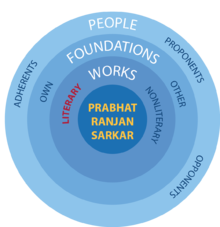User:Sharala/sandbox: Difference between revisions
m (We don't know what language the discourse was given in. Presumably Bengali.) |
|||
| Line 18: | Line 18: | ||
== Synopsis == | == Synopsis == | ||
{{Quote box|width=360px|bgcolor=|align=left|quoted=1|salign=right|quote=Parents hate to see their children weep. If they do, they take them on their lap and comfort them with love and affection until their tears stop. You will have to build a society in which no one is forced to weep, where everyone smiles joyfully all the time and gets ample scope for laughter. Seeing such mirth and merriment, Parama Puruśa will feel immensely pleased. By giving joy to Parama Puruśa you will feel even more joyful and will feel His close proximity.|source=Shrii Shrii Anandamurti}} | {{Quote box|width=360px|bgcolor=|align=left|quoted=1|salign=right|quote=Parents hate to see their children weep. If they do, they take them on their lap and comfort them with love and affection until their tears stop. You will have to build a society in which no one is forced to weep, where everyone smiles joyfully all the time and gets ample scope for laughter. Seeing such mirth and merriment, Parama Puruśa will feel immensely pleased. By giving joy to Parama Puruśa you will feel even more joyful and will feel His close proximity.|source=Shrii Shrii Anandamurti}} | ||
Anandamurti starts the discourse by saying that it is better for human beings to live and die following | Anandamurti starts the discourse by saying that it is better for human beings to live and die following ''manava dharma'' (human dharma) in lieu of trailing the dharma of others beings. Anandamurti then explains that although humans and animals share some characteristics, it's incorrect to call human beings "rational animals". Animal life is body centered while human life is an ideological flow, therefore humans are to follow ''Bhagavata dharma'' (divine characteristics). Anandamurti goes on saying that Bhagavata dharma has three distinctive attributes: Vistara (expansion), Rasa (flow) and Seva (service). Following their divine dharma, human beings pave their own path toward liberation.<ref name="AV4"/> | ||
== References == | == References == | ||
Revision as of 13:27, 19 July 2019
| Which Is the Right Path? | |
|---|---|
| Speaker | Shrii Shrii Anandamurti |
| Date | 1978 November 5 |
| Time | Morning |
| Place | Kolkata, India |
| Topic | Identifying the right direction |
| Included in | Ananda Vacanamrtam Part 4 |
| Location in Sarkarverse | |
Which Is the Right Path? is a discourse given by Shrii Shrii Anandamurti in Kolkata, India. The discourse was delivered on the morning of 1978 November 5. This discourse is the eleventh chapter of Ananda Vacanamrtam Part 4.[1]
Synopsis
Parents hate to see their children weep. If they do, they take them on their lap and comfort them with love and affection until their tears stop. You will have to build a society in which no one is forced to weep, where everyone smiles joyfully all the time and gets ample scope for laughter. Seeing such mirth and merriment, Parama Puruśa will feel immensely pleased. By giving joy to Parama Puruśa you will feel even more joyful and will feel His close proximity.
Anandamurti starts the discourse by saying that it is better for human beings to live and die following manava dharma (human dharma) in lieu of trailing the dharma of others beings. Anandamurti then explains that although humans and animals share some characteristics, it's incorrect to call human beings "rational animals". Animal life is body centered while human life is an ideological flow, therefore humans are to follow Bhagavata dharma (divine characteristics). Anandamurti goes on saying that Bhagavata dharma has three distinctive attributes: Vistara (expansion), Rasa (flow) and Seva (service). Following their divine dharma, human beings pave their own path toward liberation.[1]
References
| Preceded by Artha and Paramartha |
Ananda Vacanamrtam Part 4 With: Which Is the Right Path? |
Succeeded by It Is Better to Die While Following Bhágavata Dharma |
